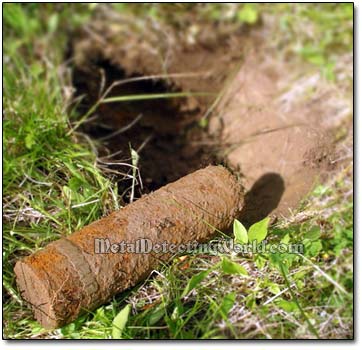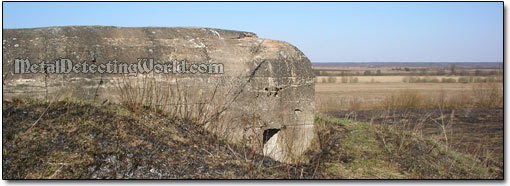Metal Detecting Research and Exploration - A Complete Guide, page 20
Dealing with Hunt Sites Infested with WW1 and WW2 Military Junk
IMPORTANT SPECIFICS
(...CONTINUED from Page 19)
Unfortunately the WW2 UXO is still abundant in the fields and imposes a serious problem on any detectorist. It is very scary and like playing a Russian roulette, but there is no other choice if you want to dig up medieval hammered coins.
WW2 Unexploded Artillery Projectile (without igniter) I Dug Up at the Site of Medieval Tavern

The rule is simple: when you receive a deep large signal, recover the target with extreme caution while making a large hole around it, and when you are sure it is a potentially dangerous military relic, leave it (if you are metal detecting in the middle of nowhere and you are sure this ordnance would not impose any danger on anybody else) or mark the site and, if possible, take a GPS reading, then report the item to the local police so they can contact the Bomb Squad/EOD/whatever the local equivalent is, and the item can be destroyed or rendered safe.
And be extremely cautious when camping at the hunt site and making camp fires. Thoroughly scan the spot, chosen for camp fire, with a metal detector. And if you receive any large iron signal, chose a different spot. Some people got seriously hurt when the buried UXO happened to be right under their camp fire and exploded from the heat.
Another problem lies in the way some not-really-smart people deal with WW2 UXO. They like to play with unexploded ordnance when they find it. Here is an example: they put a live artillery projectile INTO a camp fire! Then they hide behind the near tree. When the projectile explodes, it crushes everything within 50 meters! But that knowledge comes to a few a little bit too late... The rule is simple: "Do not screw with UXO if you don't want your sneakers dangle on a tree branch!"
Even a small unfired ammunition can cause a serious and permanent damage to your body! Just check out my page depicting the powerful potency of gunpowder extracted from the live WW2 rifle round: Testing the WW2 Gunpowder. If that is not convincing, take a look at recent US Department of Defense bulletin linked below. Graphic photo shown in the bulletin is disturbing but certainly gets the point across: photo of US Department of Defense Bulletin, 10 May 2010.
I am currently working on an article about a few lethal WW2 relics that can be found in the European fields, so please keep an eye on my announcements in the Recent Additions section.
As for the WW2 military maps, most of them would not give you the exact locations of the former "hot" military spots (not the major battlefields) at which the short but fierce fighting took place. At least the WW2 topographic maps show the front lines where the confronting armies were positioned continuously exchanging all kinds of fire for a duration of time.
As I am not a WW2 relic hunter and seldom bother with WW2 maps, I simply avoid metal detecting at the locations that are adjacent to a common soldier grave site or have a "pillbox" - a low concrete emplacement for machine guns, nearby. Both landmarks are good indicators of intense and bloody combat that took place at these locations during WW2.
WW2 Pillbox Observing a Field - Site of Medieval Village
